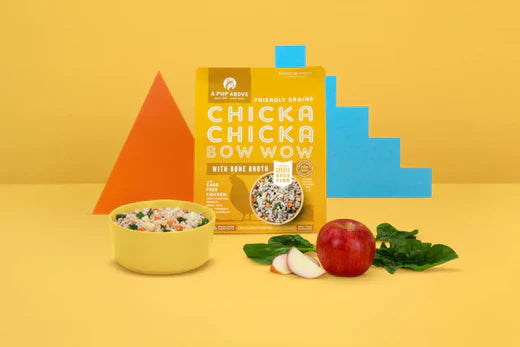
What Is Hydrolyzed Protein Dog Food?
In our journey to provide the very best for our dogs, we often encounter choices that go beyond the simple kibble versus canned food debate.
At A Pup Above, we champion the cause of feeding our dogs high-quality, human-grade meals, recognizing the diverse needs of every pup out there. But what about the buzz around hydrolyzed protein dog food?
Let's dig into the world of specialized dog diets and uncover the role hydrolyzed protein plays in nurturing our pets.
What Is Hydrolyzed Protein Dog Food?
Imagine taking a protein, which is essentially a large molecule, and breaking it down into its puzzle pieces — smaller peptides and amino acids. This is the essence of hydrolyzed protein dog food.
Through hydrolysis, proteins are rendered into components so minute that they can easily bypass the radar of a dog's immune system, which is a boon for pups with food sensitivities or allergies.
This process not only makes the food highly digestible but also minimizes the risk of adverse food reactions, offering a novel approach to managing and preventing dietary sensitivities in dogs.
What Are the Benefits of Hydrolyzed Protein for Dogs?
When it comes to the well-being of our dogs, every little choice can make a big difference. Hydrolyzed protein dog food brings a bunch of advantages to the table. Let’s explore how this special diet can contribute to a happier, healthier life for dogs with specific dietary needs.
Enhanced Digestibility
The magic of hydrolyzed protein lies in its ease of digestion. Because the proteins are broken down into smaller components, they’re much easier for dogs to absorb. This means more of the nutrients in their food are utilized by their bodies, supporting everything from muscle repair to maintaining a healthy coat.
Allergy Management
For dogs battling food allergies, hydrolyzed protein is a game-changer. Reducing the protein molecules to sizes too small for the immune system to recognize as allergens significantly lowers the chance of an allergic reaction. This can mean fewer skin irritations, less gastrointestinal upset, and an overall happier pooch.
Supports Sensitive Stomachs
Some dogs have stomachs that are more sensitive than others, and finding a diet that doesn’t cause upset can be challenging. Hydrolyzed protein foods are gentle on the stomach, making them an excellent option for pets prone to digestive issues.
Suitable for All Life Stages
One of the great things about hydrolyzed protein dog food is its versatility. Suitable for puppies, adults, and seniors alike, it ensures that dogs of all ages can benefit from a diet that’s both nutritious and easy on their system. This adaptability makes it an excellent choice for households with multiple dogs of different ages.
Are There Any Drawbacks to Hydrolyzed Protein?
Every coin has two sides, and while hydrolyzed protein dog food is a godsend for many, it's essential to weigh the potential drawbacks, too.
Here's a look at some considerations pet owners should keep in mind:
Cost
One of the first things you might notice is the price tag. Hydrolyzed protein dog food often comes at a premium. The specialized process of breaking down proteins into their constituent amino acids and peptides requires additional steps and resources, which is reflected in the cost.
Palatability
Not every pup is going to be a fan of the taste or texture of hydrolyzed protein food. While many adapt quickly, others may need some coaxing. Finding the right balance between health benefits and what your dog actually enjoys eating can sometimes be a challenge.
Limited Variety
Compared to conventional dog foods, the range of hydrolyzed protein options can be somewhat limited. This might mean fewer flavors or brands to choose from, which can be a drawback for dogs who like variety or are particularly picky eaters.
Not Necessary for All Dogs
It's also important to remember that not all dogs need a hydrolyzed protein diet. The benefits might not outweigh the costs for pets without food sensitivities, allergies, or specific health issues that such a diet addresses. It's always best to consult a veterinarian to determine if hydrolyzed protein is the right choice for your dog.
Transition Time
Switching to a hydrolyzed protein diet isn't always straightforward and requires a transition period to avoid digestive upset. This process demands patience and careful monitoring to ensure your dog adjusts well, which might be a drawback for some pet owners.
What's the Scoop on Fresh Dog Food?
In the quest for optimal canine health, the conversation often turns to specialized diets, like hydrolyzed protein dog food. But where does fresh, human-grade dog food fit into this picture? At A Pup Above, we believe that while specific dietary needs are crucial, the foundation of any dog's diet should be rooted in quality and wholesomeness.
Quality First
Whether you're exploring hydrolyzed protein options for allergy management or other health concerns, the quality of ingredients should never take the back seat. Our meals, from the rich Texas Beef Stew to the delightful Chicka Chicka Bow Wow, are crafted with top-tier, non-GMO ingredients, ensuring your dog gets the best, regardless of dietary restrictions.
Digestive Delight
High digestibility is key for all dogs — especially those on specialized diets. Fresh, human-grade food provides an easily digestible option that's gentle on your pup's stomach.
Irresistible Flavor
Every pup deserves to relish their meals. Our sous-vide cooking method locks in flavors, making even specialized diet transitions more appealing and less of a chore.
Broad Spectrum Health Benefits
Beyond addressing specific dietary needs, fresh dog food supports overall health — from a lustrous coat to robust immunity.
Informed Choice
Navigating dietary choices for your dog means understanding all the options. While hydrolyzed protein dog food serves a purpose, integrating or choosing fresh, human-grade food is about offering the best — not just meeting specific needs.
How Do I Transition My Dog to a New Dog Food?
Switching your dog to a new food is like introducing a toddler to a new veggie — it requires finesse.
Here's how to ensure the switch is as smooth as a bowl of our savory Turkey Pawella:
- Gradual Introduction: Start by mixing a small amount of the new food with the old, gradually increasing the new while decreasing the old over several days.
- Keep an Eye Out: Monitor your dog for any signs of digestive discomfort or food refusal, adjusting the transition pace as needed.
- Stay Hydrated: Ensure your dog has constant access to fresh water, especially as their body adjusts to the new diet.
- Patience Pays: Some dogs may take a bit longer to adjust to new flavors or textures, so patience and persistence are key.
- Vet Check: Consulting with your vet before and during the transition can provide valuable guidance tailored to your dog's specific health needs.
The Bottom Line
At A Pup Above, we're all about enriching your dog's life with meals that delight, nourish, and support their health from the inside out. Whether you're diving deep into the world of hydrolyzed protein dog food for specific health reasons or serving up our fresh, human-grade meals, know that you're doing wonders for your dog's wellbeing.
Remember, the best diet for your dog is one that meets their unique nutritional needs, and we're here to help you make those mealtime moments truly special.
Sources:
What is hydrolyzed protein? | USDA
Hydrolyzed Protein - an overview | ScienceDirect Topics
Hydrolyzed diets may stimulate food-reactive lymphocytes in dogs | PMC
How to Switch Dog Foods: Transitioning Your Dog's Diet | American Kennel Club (AKC)
Top Stories

Why Do Dogs Lick Their Paws?

Why Do Dogs Whimper & Make Noises in Their Sleep?

Healthy Vet-Approved Homemade Dog Food Recipes

How To Cook Sweet Potatoes for Dogs






















